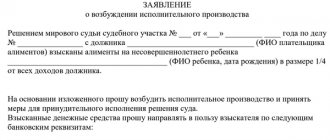Home / Alimony / Methods and procedures for paying child support
The legislation quite clearly and strictly regulates parental responsibilities. But this does not mean that parents are not endowed with rights and freedoms, in particular, the right to independently choose the method and procedure for supporting their children.
Depending on the circumstances and the choice of the parents, the payment of alimony can be voluntary or forced, one-time or regular, the amount of cash payments can be constant or variable, the methods of paying money can also be very different - in the form of cash, postal or bank transfers.
Each of these methods of paying child support has different legal and practical features, and parents should study each of them in detail and compare them with their life circumstances before they make a thoughtful and informed choice.
Grounds for assigning alimony. Terms of their payments
Cessation of providing financial support to one’s own child is a reason for imposing child support obligations. Oral agreements can be reached between spouses, but they cannot guarantee the regular and timely fulfillment of mutual obligations.
The official basis for the assignment of alimony payments is: a notarized agreement, a court order and a writ of execution issued on the basis of a decision of the judicial authorities.
Parents' payment agreement
Parents of children who sit down at the negotiating table can reach agreement on the issue of financial support for their offspring. An agreement may be signed to formalize such arrangements. This document establishes the amount of maintenance, the procedure and timing of its payments.
To give it legal significance, a notarization is required. The notary is obliged to check the compliance of the established obligations with the norms of the current legislation, in order to prevent the deterioration of the rights of minors. The notary certifies the will of the parties with his signature.
An agreement to provide material support can be recorded both at the time of the existence of the marriage and after its dissolution. Due to the fact that it is of a contractual nature, the parties have the right to determine the deadline for fulfilling obligations at their own discretion. Thus, the start date of payments must be indicated in the document, which also records the frequency of payments and their end date.
Often, child support is paid monthly, from the date the agreement is signed, and ends when the child reaches adulthood.
Court order
Receiving such an order is the most unique and fastest opportunity to obtain a writ of execution in a simplified manner. It does not require a full-fledged procedural hearing to be issued. The magistrate issues an order based on the documents submitted by the applicant, after which he notifies the interested parties.
The court order is subject to immediate execution by the bailiffs. Its operative part specifies the period for collection. As the start date for calculating alimony, the magistrate indicates the date the applicant applied to the court. As a general rule, payments end with the onset of your 18th birthday.
Performance list
This procedural document is issued on the basis of a court decision. Its adoption is preceded by a trial conducted in the general manner, with the summoning of the parties, proving their positions, and hearing testimony.
To obtain a writ of execution, the future recipient of the contents must contact the defendant through the judicial authorities, to which the relevant claim must be sent. In order to consider the dispute, the parties will be summoned to the meeting, who, on the basis of adversarial arguments, will be able to justify their legal position to an independent court.
The court determines the date of commencement of the existence of the defendant's alimony obligations as the date of filing the claim. Thus, at the time of receiving the writ of execution, the defendant may already owe several monthly payments. Both in the court decision and in the sheet issued on its basis, the end date of obligations is determined by the date of the 18th birthday of the child in respect of whom maintenance is established.
Is it possible to pay child support directly to a child?
Some alimony payers doubt that the amounts of money they transfer to support their son or daughter are spent correctly, according to the needs of the child. The methods of paying alimony provided by law do not suit them, and they often offer an alternative method: depositing alimony into a bank account belonging to the child, without the right of access to funds from his close relatives (usually the mother).
This possibility is provided for in the law (clause 2 of article 60 of the RF IC).
But the use of this possibility should not be unauthorized, but only by court decision - if there are good reasons for this. The alimony payer will have to file a claim and attach evidence of misuse of alimony.
No more than 50% of payments can be deposited into a bank account opened in the name of a minor child . The rest of the amount must be transferred to the parent who directly lives with the child, raises and supports him.
For more information on how to prove alimony is being spent for other purposes and to organize the subsequent payment of funds for child support, see the article “Misuse of alimony.”
Expert opinion
Semyon Frolov
Lawyer. 7 years of experience. Specialization: family, inheritance, housing law.
If, after reading the article, you still have questions about the procedure for collecting and paying alimony, and also if you need personal advice from a lawyer, write or call us!
We will advise you free of charge. Many difficulties and family disputes are resolved thanks to timely legal assistance - without court or executive service. The lawyer will advise which method of paying alimony to prefer, will help with drawing up an alimony agreement, and if you cannot do without a trial, will provide assistance in drawing up a claim and collecting documents, and, if necessary, will support you in court in order to competently and reliably defend the interests of the child or parent . Attention!
- Due to frequent changes in legislation, information sometimes becomes outdated faster than we can update it on the website.
- All cases are very individual and depend on many factors. Basic information does not guarantee a solution to your specific problems.
That's why FREE expert consultants work for you around the clock!
- via the form (below), or via online chat
- Call the hotline:
- Moscow and the Region
- St. Petersburg and region
- FREE for a lawyer!
By submitting data you agree to the Consent to PD Processing, PD Processing Policy and User Agreement.
Anonymously
Information about you will not be disclosed
Fast
Fill out the form and a lawyer will contact you within 5 minutes
Tell your friends
Rate ( 1 ratings, average: 5.00 out of 5)
Author of the article
Irina Garmash
Family law consultant.
Author's rating
Articles written
612
Consequences that occur if payment deadlines are not met
The use of coercive measures is a consequence of non-compliance with the terms of payment of alimony and the formation of debt.
Today, defaulters can be brought to civil, administrative or criminal liability. The specific punishment is determined by the judicial authorities depending on the degree of guilt of the debtor, his financial and marital status.
In order to bring the defaulter to justice, a debt collector or a bailiff may contact law enforcement agencies.
Penalties may serve as civil liability measures. The debtor's actions may be regarded as an administrative offense, as a result of which he will be fined or deprived of his driver's license. The most severe punishment is criminal prosecution.
In addition, the recipient of alimony may deprive the obligee of parental rights, which will relieve the joint child from the obligation to provide for the parent in the future.
Basic Concepts
Alimony is payments that persons specified in the Family Code must pay to certain categories of citizens (children, disabled parents, and so on). Recipients of alimony are to some extent financially dependent on payers (due to family ties and other circumstances).
The alimony payer is a person obliged to provide for the recipient within the limits established by an agreement or judicial act, and the recipient is a person who accepts such security from the payer.
An alimony agreement is a document voluntarily concluded between the payer and the recipient, on the basis of which alimony payments are calculated.
Division of child support is the process of distributing child support payments among all recipients.
The division is necessary for a more equitable distribution of funds, taking into account many factors, including the family and financial status of the parties.
Debt calculation and penalties
Debt arising as a result of refusal to fulfill alimony obligations based on one of the executive documents is subject to collection in court.
In order to initiate legal proceedings, the court must be provided with evidence of the existence of the debt, and, if a penalty is sought to be collected, also its calculation.
The debt calculation issued by the bailiff can be used as evidence of the debtor's failure to fulfill the obligations of the debtor.
A sample debt collection application can be found here.
A penalty, in its essence, is one of the ways of materially punishing a debtor; on the other hand, its possible collection is a kind of incentive for those payers who make payments regularly and try to avoid delays under any circumstances.
The penalty must be calculated by the claimant himself. If the debt is based on a court order or writ of execution, the fine will be 0.5% daily. A higher or lower level of penalties can be determined only on the basis of an agreement certified by a notary.
The mechanism for the occurrence of alimony obligations
An alimony obligation cannot arise between any two people because it is personal in nature. This means that the alimony payer and the alimony recipient:
- They are family members for each other (parents, spouses, children, adoptive parents) or close relatives (brothers, grandfathers, sisters, grandmothers, grandchildren and granddaughters).
- Have documents confirming their relationship or family connection. In Russia, the state registry office is responsible for issuing such documents. Usually these are various certificates, for example, about divorce, about adoption, about birth, about marriage.
The second point in the above list is key, since the lack of documents on kinship prevents the claim of alimony from a potential relative. Let's give the following example: after the birth of the child, the father refused to go with the mother to the state registry office and register in the register as the parent of the newborn, and the mother did not insist on this or did not want to recognize paternity through the court. Thus, in the birth certificate of a minor, the column about the father will be empty, although, of course, the child has a biological father, unless he has died. As a result, it turns out that this man cannot be legally obliged to pay alimony, impose a penalty on him for untimely fulfillment of the alimony obligation, or other unfavorable legal sanctions.
Collection of property from the debtor
The alimony payment arrears established by a court decision can be collected not only from the debtor’s earnings, but also from the property belonging to him.
This right is one of the methods of legislative protection of recipients of alimony payments. Its use is possible only in exceptional cases when the debtor’s income level does not allow him to repay the debt and make monthly payments.
Lack of income gives bailiffs the right to foreclose on funds placed in bank accounts or transferred on a contractual basis to various organizations. If they are absent or they are also insufficient, recovery can be made on a land share, a share in the authorized capital, a share in the common property, by allocating it in kind.
The bailiff has the right to foreclose on securities, shares, bonds, checks, property and other property belonging to the debtor.
Where to contact
An application for division of alimony payments must be submitted to the court. This category of cases is dealt with only by the magistrate’s court, regardless of the amount of alimony and other circumstances.
The application must be made in writing. It indicates all the circumstances relevant to the case, including the rationale for the division of alimony payments (for example, the presence of another recipient for this payer).
Any interested party can submit an application. This can be either a representative of the recipient of alimony (the parent with whom the child lives) or the payer himself, if he believes that the current procedure for dividing alimony payments infringes on his rights or the rights of the recipient.
Is alimony charged on premiums? The answer is presented in the article “How alimony is withheld from bonuses.” You can find out how to collect alimony from an individual entrepreneur (IP) here.
Transfer to card
The fastest transfer method is transfer to the recipient's card .
There are several ways to transfer to a card.
The most popular of them is card-to-card transfer.
In most cases, such a transfer occurs instantly.
The main advantages of this method of paying alimony are:
- The payer himself controls the sending of funds;
- There is no need to go to a bank office; it is enough to have funds on the card;
- There is no need to fill out payment details, you can only indicate the recipient’s card number or use , indicating the recipient’s phone number linked to the card account;
- At any convenient time, you can print a receipt for completed transactions or request a bank statement to prove the fact of payment.
If it is impossible to transfer from card to card (for example, the cards have different payment systems or the payer is not satisfied with the amount of commission charged), you can make a transfer in the following ways:
- Transfer to the alimony recipient's card through a bank office in cash or by transfer from a bank account.
In most methods, you must indicate not only the recipient's card number, but also all the card account details. - Transfer to the recipient's card by depositing cash through a service terminal.
- By depositing funds onto the recipient's card at payment acceptance points - Svyaznoy, Euroset, Beeline, etc., indicating payment information.
Popular methods of transferring to a card are also:
translation of “Golden Crown”, “Western Union”, “Kiwi”.









